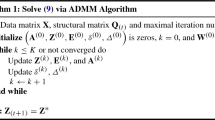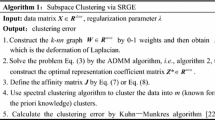Abstract
In this research paper, we consider the subspace clustering problem which aims at finding a low-dimensional representation of a high-dimensional data set. In particular, our central focus is upon the least squares regression based on which we elaborate an adaptive weighted least squares regression for subspace clustering. Compared to the least squares regression, we consider the data locality to adaptively select relevant and close samples and discard irrelevant and faraway ones. Additionally, we impose a weight matrix on the representation errors to adaptively highlight the meaningful features and minimize the effect of redundant/noisy ones. Finally, we also add a non-negativity constraint on the representation coefficients to enhance the graph interpretability. These interesting properties allow to build up a more informative and quality graph, thereby yielding very promising clustering results. Extensive experiments on synthetic and real databases demonstrated that our clustering method achieves consistently optimal results, compared to multiple clustering methods.






Similar content being viewed by others
Notes
http://www.cad.zju.edu.cn/home/dengcai/Data/FaceData.html.
http://www.cs.columbia.edu/CAVE/software/softlib.
http://www.gaussianprocess.org/gpml/data/.
http://yann.lecun.com/exdb/mnist/.
References
Ben Abdallah F, Feki G, Ben Ammar A, Ben Amar C (2018) Multilevel deep learning-based processing for lifelog image retrieval enhancement. In: 2018 IEEE international conference on systems, man, and cybernetics (SMC), pp 1348–1354
Bouchrika T, Zaied M, Jemai O, Ben Amar C (2012) Ordering computers by hand gestures recognition based on wavelet networks. In: CCCA12, pp 1–6
Bouhlel N, Feki G, Ben Ammar A, Ben Amar C (2017) A hypergraph-based reranking model for retrieving diverse social images. In: Lecture Notes in Computer Science, vol 10424 LNCS, Springer International Publishing, Cham, pp 279–291
Bouhlel N, Feki G, Ben Ammar A, Ben Amar C (2020) Hypergraph learning with collaborative representation for image search reranking. Int J Multimedia Inform Retrieval
Bouhlel N, Ksibi A, Ben Ammar A, Ben Amar C (2016) Semantic-aware framework for Mobile Image Search. In: International conference on intelligent systems design and applications, ISDA, vol 2016, IEEE, pp 479–484
Chen Y, Yi Z (2019) Locality-constrained least squares regression for subspace clustering. Knowledge-Based Systems 163:51–56
Elhamifar E, Vidal R (2009) Sparse subspace clustering. In: 2009 IEEE conference on computer vision and pattern recognition, pp 2790–2797
Esser E (2010) Applications of lagrangian-based alternating direction methods and connections to split bregman ernie esser
Fakhfakh R, Feki G, Ben Ammar A, Ben Amar C (2016) Personalizing information retrieval: A new model for user preferences elicitation. In: 2016 IEEE international conference on systems, man, and cybernetics (SMC), pp 002091–002096
Feki G, Ben Ammar A, Ben Amar C (2014) Adaptive semantic construction for diversity-based image retrieval. In: Proceedings of the international joint conference on knowledge discovery, knowledge engineering and knowledge management, Vol 1, p 444–449. SCITEPRESS - Science and Technology Publications, Lda, Setubal, PRT
Feki G, Ksibi A, Ben Ammar A, Ben Amar C (2013) Improving image search effectiveness by integrating contextual information
Georghiades AS, Belhumeur PN, Kriegman DJ (2001) From few to many: illumination cone models for face recognition under variable lighting and pose. IEEE Trans Pattern Anal Mach Intell 23(6):643–660
Hoerl AE, Kennard RW (1970) Ridge regression: applications to nonorthogonal problems. Technometrics 12(1):69–82
Hu H, Lin Z, Feng J, Zhou J (2014) Smooth representation clustering. 2014 IEEE conference on computer vision and pattern recognition, pp 3834–3841
Huang J, Nie F, Huang H (2015) A new simplex sparse learning model to measure data similarity for clustering. IJCAI International Joint Conference on Artificial Intelligence 2015-Janua(Ijcai), pp 3569–3575
Jing L, Ng MK, Huang JZ (2007) An entropy weighting k-means algorithm for subspace clustering of high-dimensional sparse data. IEEE Trans Knowl Data Eng 19(8):1026–1041
Ksibi A, Feki G, Ammar AB, Amar C (2013) Effective diversification for ambiguous queries in social image retrieval. In: CAIP
Lai Z, Xu Y, Chen Q, Yang J, Zhang D (2014) Multilinear sparse principal component analysis. IEEE Trans Neural Netw Learn Syst 25(10):1942–1950
Liu G, Lin Z, Yu Y (2010) Robust Subspace Segmentation by Low-Rank Representation. In: Proceedings of the 27th international conference on international conference on machine learning. Omnipress, Madison, WI, USA
Liu J, Chen Y, Zhang J, Xu Z (2014) Enhancing Low-Rank Subspace Clustering by Manifold Regularization 23(9): 4022–4030
Lu C, Min H, Zhao Z.Q, Zhu L, shuang Huang D, Yan S (2012) Robust and efficient subspace segmentation via least squares regression. In: ECCV (2012)
Luxburg UV (2006) A tutorial on spectral clustering. Tech Rep pp 1–32
Nie F, Wang X, Jordan MI, Huang H (2016) The constrained laplacian rank algorithm for graph-based clustering. 30th AAAI Conference on Artificial Intelligence, AAAI 2016 (1), pp 1969–1976
Peng C, Kang Z, Cheng Q (2017) Subspace clustering via variance regularized ridge regression. In: 2017 IEEE conference on computer vision and pattern recognition (CVPR), pp 682–691
Peng X, Yu Z, Yi Z, Tang H (2017) Constructing the L2-graph for robust subspace learning and subspace clustering. IEEE Trans Cybern 47(4):1053–1066
Peng X, Zhang L, Yi Z (2013) Scalable sparse subspace clustering. In: 2013 IEEE conference on computer vision and pattern recognition, pp 430–437
Samaria FS, *t, F.S.S., Harter A, Site OA (1994) Parameterisation of a stochastic model for human face identification
Shi J, Malik J (2000) Normalized cuts and image segmentation. IEEE Trans Pattern Anal Mach Intell 22:888–905
Tang M, Nie F, Jain R (2016) Capped lp-norm graph embedding for photo clustering. In: Proceedings of the 24th ACM International Conference on Multimedia, MM ’16, pp 431–435. Association for Computing Machinery, New York, NY, USA
Tang M, Nie F, Jain R (2017) A graph regularized dimension reduction method for out-of-sample data. Neurocomputing 225:58–63
Vidal R (2011) Subspace Clustering. IEEE Signal Process Magaz 28(2):52–68. https://doi.org/10.1109/MSP.2010.939739
Wen J, Fang X, Xu Y, Tian C, Fei L (2018) Low-rank representation with adaptive graph regularization. Neural Netw 108:83–96
Zheng J, Yang P, Chen S, Shen G, Wang W (2017) Iterative re-constrained group sparse face recognition with adaptive weights learning. IEEE Trans Image Process 26:2408–2423
Zhuang L, Gao H, Lin Z, Ma Y, Zhang X, Yu N (2012) Non-negative low rank and sparse graph for semi-supervised learning. 2012 IEEE Conference on Computer Vision and Pattern Recognition, pp. 2328–2335
Zou H, Hastie TJ (2005) Regularization and variable selection via the elastic net
Acknowledgements
The research leading to these results has received funding from the Ministry of Higher Education and Scientific Research of Tunisia under the grant agreement number LR11ES48.
Author information
Authors and Affiliations
Corresponding author
Additional information
Publisher's Note
Springer Nature remains neutral with regard to jurisdictional claims in published maps and institutional affiliations.
Rights and permissions
About this article
Cite this article
Bouhlel, N., Feki, G. & Ben Amar, C. Adaptive weighted least squares regression for subspace clustering. Knowl Inf Syst 63, 2883–2900 (2021). https://doi.org/10.1007/s10115-021-01612-1
Received:
Revised:
Accepted:
Published:
Issue Date:
DOI: https://doi.org/10.1007/s10115-021-01612-1




